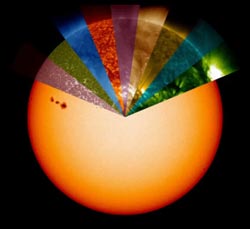NASA's SDO Shows the Sun's Rainbow of Wavelengths

<br>
Telescopes can also collect light in ranges that our eyes alone cannot see, providing scientists ways of observing a whole host of material and processes that would otherwise be inaccessible.
A new NASA movie of the sun based on data from NASA's Solar Dynamics Observatory, or SDO, shows the wide range of wavelengths – invisible to the naked eye – that the telescope can view. SDO converts the wavelengths into an image humans can see, and the light is colorized into a rainbow of colors.
As the colors sweep around the sun in the movie, viewers should note how different the same area of the sun appears. This happens because each wavelength of light represents solar material at specific temperatures. Different wavelengths convey information about different components of the sun's surface and atmosphere, so scientists use them to paint a full picture of our constantly changing and varying star.
Yellow light of 5800 Angstroms, for example, generally emanates from material of about 10,000 degrees F (5700 degrees C), which represents the surface of the sun. Extreme ultraviolet light of 94 Angstroms, which is typically colorized in green in SDO images, comes from atoms that are about 11 million degrees F (6,300,000 degrees C) and is a good wavelength for looking at solar flares, which can reach such high temperatures.
By examining pictures of the sun in a variety of wavelengths – as is done not only by SDO, but also by NASA's Interface Region Imaging Spectrograph, NASA's Solar Terrestrial Relations Observatory and the European Space Agency/NASA Solar and Heliospheric Observatory — scientists can track how particles and heat move through the sun's atmosphere.
Karen C. Fox
NASA's Goddard Space Flight Center, Greenbelt, Md.
Media Contact
All latest news from the category: Physics and Astronomy
This area deals with the fundamental laws and building blocks of nature and how they interact, the properties and the behavior of matter, and research into space and time and their structures.
innovations-report provides in-depth reports and articles on subjects such as astrophysics, laser technologies, nuclear, quantum, particle and solid-state physics, nanotechnologies, planetary research and findings (Mars, Venus) and developments related to the Hubble Telescope.
Newest articles

Webb captures top of iconic horsehead nebula in unprecedented detail
NASA’s James Webb Space Telescope has captured the sharpest infrared images to date of a zoomed-in portion of one of the most distinctive objects in our skies, the Horsehead Nebula….

Cost-effective, high-capacity, and cyclable lithium-ion battery cathodes
Charge-recharge cycling of lithium-superrich iron oxide, a cost-effective and high-capacity cathode for new-generation lithium-ion batteries, can be greatly improved by doping with readily available mineral elements. The energy capacity and…

Novel genetic plant regeneration approach
…without the application of phytohormones. Researchers develop a novel plant regeneration approach by modulating the expression of genes that control plant cell differentiation. For ages now, plants have been the…





















